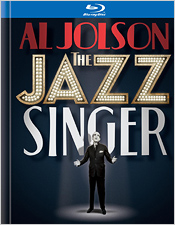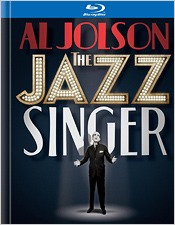Jazz Singer, The (Blu-ray Review)

Director
Alan CroslandRelease Date(s)
1927 (January 8, 2013)Studio(s)
Warner Bros.- Film/Program Grade: A
- Video Grade: A-
- Audio Grade: B+
- Extras Grade: A
Review
Wait a minute, wait a minute… you ain’t heard nothin’ yet!
The words weren’t particularly new, but they made for the lines heard ‘round the world when Al Jolson uttered them onscreen in Warner Bros.’ 1927 film The Jazz Singer. The boast was a familiar part of Jolson’s patter, honed over years of performing onstage. But they took on new meaning when uttered on the motion picture screen by the world’s biggest entertainer, speaking not just to a club crowd in the film but also to the audiences out there in the dark. The Jazz Singer wasn’t the first sound film; many earlier short subjects had included spoken dialogue. Warner Bros.’ own Don Juan (1926) had a synchronized instrumental score as well as sound effects. The Jazz Singer, though, was the first feature film to feature a synchronized score, sound effects, singing and dialogue. The total speaking in the film adds up to roughly two minutes’ worth, with the rest of the dialogue handled via standard caption cards. But those two electrifying minutes marked the death knell for the silent film era. Though the transition to sound wasn’t immediate, sound-equipped theatres had grown from a mere handful in 1927 to thousands by the end of 1928. Its success put Warner Bros. on the map. Some 85 years later, the studio has recently issued The Jazz Singer for the first time on Blu-ray in a deluxe new three-disc edition that explores this landmark film from virtually every angle.
The main attraction here is a print that shows just how crisp a nearly 86-year old film can look on Blu-ray in 1080p. But even notwithstanding its technological innovations, The Jazz Singer still holds up thanks to its accessible, classic story and the confident, if unadorned, direction by Alan Crosland. In the screenplay by Alfred A. Cohn and Jack Jarmuth based on the play by Samson Raphaelson, Jolson’s Jakie Rabinowitz doesn’t wish to follow in the footsteps of his cantor father (Warner Oland), one of five generations of cantors. Jakie flies the familial coop, and when he returns as jazz-singing Jack Robin, his father is less than understanding. Naturally, the themes of rebellion and heritage still resonate today. (The very first caption card reads, “In every living soul, a spirit cries for expression,” a truism if there ever was one.) Make no mistake, The Jazz Singer was still very much an embryonic sound picture; some may find the film’s frequent transitions from singing and/or speaking back into silent mode (with scenes accompanied by the orchestral score, of course) to be jarring. And while the film’s melodramatic aspects didn’t go unnoticed even in 1927, the performances of Jolson, Oland, Eugenie Besser as Jack’s mother Sara and May McAvoy as Jack’s love interest Mary are all vividly memorable, however broad they may be in a modern context.
Jolson’s piercing eyes convey his character’s inner conflict, and he’s as magnetic outside of the musical performances as he is in them. And music is central to The Jazz Singer. Popular songs like “Dirty Hands, Dirty Face” (his first in the movie), “Toot, Toot, Tootsie (Goo’Bye),” “Blue Skies” and “My Mammy” all play major roles in the film, as do the traditional “Kaddish” and “Kol Nidre.” The orchestral score is equally important, and incredibly well-conceived. When Jack receives news that he’ll be taking his act to Broadway, George M. Cohan’s “Give My Regards to Broadway” is heard. “Mother of Mine” makes an appearance when Jack reunites with his mother, of course. (In an early example of a record tying into a film soundtrack, Brunswick Records released Jolson’s rendition of the song to capitalize on The Jazz Singer.) Besser and Jolson share the pivotal first true dialogue sequence ever heard in a full-length motion picture which integrates music and conversation. Following a heartfelt performance of Irving Berlin’s “Blue Skies,” Jack remains at his father’s piano, speaking with Sara as he continues to tickle the ivories. He then “sings it jazzy” before his horrified father enters and makes a powerful utterance himself. Though The Jazz Singer itself then reverts back to caption cards, the movies were never the same after this sequence. Even more impressive is the fact that the dialogue in this scene between Jolson and Besser was reportedly the result of improvisation.
On the first disc of the set, the film’s BD premiere is accompanied by a commentary track, a collection of cartoons and shorts, a 1947 radio broadcast with Jolson reprising his role, and the theatrical trailer. All of these features have been ported over from the 80th anniversary DVD edition from 2007. The commentary by film historian Ron Hutchinson and musician/bandleader Vince Giordano is wide-ranging, conversational and entertaining. The two men discuss the filming locations as well as the Vitaphone system that made the sound breakthroughs possible, the artful construction of the musical score, and the use of stereotypes and blackface. Jolson’s famous blackface turn in the film is by its nature uncomfortable today, and Hutchinson and Giordano take pains to point out that Jolson didn’t use the technique to adopt a dialect or otherwise alter his performance. Rather, he hoped the make-up would highlight his features all the way to the back row when lit properly. (Though Jolson remains a controversial figure due to the blackface style, he staunchly fought discrimination, casting and supporting African-Americans throughout his career.)
The 1936 Tex Avery-directed Merrie Melodies short I Love to Singa is among the bonus features, and it’s an absolutely delightful eight minutes as it distills the story of The Jazz Singer to its essence with a young owl who rebels against his parents and reinvents himself as “Owl Jolson.” Another treat here is the real Jolson’s 1926 Vitaphone short A Plantation Act. Long thought lost, this film was restored for the 2007 DVD, and basically preserves much of Jolson’s stage act on a (somewhat unfortunate) plantation set. In blackface, he sings “April Showers,” “Rock-a-Bye Your Baby with a Dixie Melody” and “When the Red, Red, Robin Comes Bob, Bob, Bobbin’ Along” directly to the audience. He even uses his “Wait a minute, wait a minute…” speech in this short and takes bows! (Alas, the chicken joining him on set doesn’t get any due.)
The remaining two discs in the new BD edition are standard DVDs, replicated from the 2007 box set. One disc is a retrospective of the early sound era and includes the full-length documentary The Dawn of Sound: How Movies Learned to Talk along with another handful of shorts. The final disc offers a staggering array of over 20 Vitaphone shorts made between 1926 and 1936 with stars such as Baby Rose Marie (later of The Dick Van Dyke Show and Hollywood Squares), George Burns and Gracie Allen, and the Foy Family. Warner Bros. is to be commended for having included all of the special features from the 2007 edition save the trailer gallery for other Jolson films. The three discs are packaged in the studio’s popular Blu-ray book format, with a larger-than-usual book. Its 88 pages allow for the inclusion of virtually all of the printed material in the DVD set (with the exception of some postcards) such as the film’s souvenir book and another pamphlet about the Vitaphone sound process. The book is loaded with photographs, cast biographies, and a brief but compelling history of The Jazz Singer.
Though it’s easy to wish that Warner Bros. would have commissioned a new documentary specifically on the film to mark its Blu-ray debut, the set is still comprehensive. The high quality of the detailed, clean print more than justifies its upgrade from DVD. The DTS-MA mono audio track is bit of a luxury for a 1927 soundtrack, but it doesn’t disappoint, especially for Louis Silvers’ supple orchestral score. (Jolson’s associate Silvers also penned the star’s famous “April Showers.”) English SDH subtitles are included. At a climactic moment in the film, Cantor Rabinowitz realizes, “He’s not my boy anymore; he belongs to the world now.” As does The Jazz Singer. Though remade twice (first with Danny Thomas and Peggy Lee, and then with Neil Diamond and Lucie Arnaz), the original still retains its power. That power has rarely been more evident than on this sparkling, gorgeous Blu-ray revival.
- Joe Marchese


